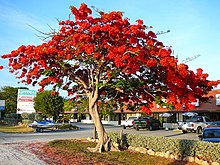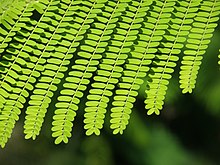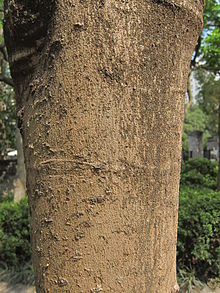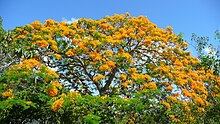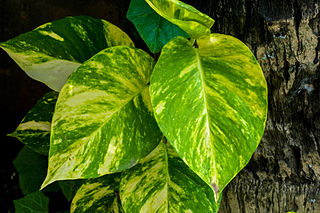
Epipremnum aureum is a species in the arum family Araceae, native to Mo'orea in the Society Islands of French Polynesia. The species is a popular houseplant in temperate regions but has also become naturalised in tropical and sub-tropical forests worldwide, including northern South Africa, Australia, Southeast Asia, South Asia, the Pacific Islands and the West Indies, where it has caused severe ecological damage in some cases.

Lagerstroemia, commonly known as crape myrtle, is a genus of around 50 species of deciduous and evergreen trees and shrubs native to the Indian subcontinent, southeast Asia, northern Australia, and other parts of Oceania, cultivated in warmer climates around the world. It is a member of the family Lythraceae, which is also known as the loosestrife family. The genus is named after Swedish merchant Magnus von Lagerström, a director of the Swedish East India Company, who supplied Carl Linnaeus with plants he collected. These flowering trees are beautifully colored and are often planted both privately and commercially as ornamentals.

Coccoloba uvifera is a species of tree and flowering plant in the buckwheat family, Polygonaceae, that is native to coastal beaches throughout tropical America and the Caribbean, including central & southern Florida, the Bahamas, the Greater and Lesser Antilles, and Bermuda. Common names include seagrape and baygrape.

The waratah (Telopea) is an Australian-endemic genus of five species of large shrubs or small trees, native to the southeastern parts of Australia. The best-known species in this genus is Telopea speciosissima, which has bright red flowers and is the New South Wales (NSW) state emblem. The waratah is a member of the family Proteaceae, flowering plants distributed in the Southern Hemisphere. The key diagnostic feature of Proteaceae is the inflorescence, which is often very large, brightly coloured and showy, consisting of many small flowers densely packed into a compact head or spike. Species of waratah boast such inflorescences ranging from 6–15 cm in diameter with a basal ring of coloured bracts. The leaves are spirally arranged, 10–20 cm long and 2–3 cm broad with entire or serrated margins. The name waratah comes from the Eora Aboriginal people, the pre-European inhabitants of the Sydney area.

Cassia fistula, also known as golden shower, purging cassia, Indian laburnum, kani konna, or pudding-pipe tree, is a flowering plant in the family Fabaceae. The species is native to the Indian subcontinent and adjacent regions of Southeast Asia. It is the official state flower of Kerala state in India. It is also a popular ornamental plant and is also used in herbal medicine.

Ficus elastica, the rubber fig, rubber bush, rubber tree, rubber plant, or Indian rubber bush, Indian rubber tree, is a species of flowering plant in the family Moraceae, native to eastern parts of South and Southeast Asia. It has become naturalized in Sri Lanka, the West Indies, and the US state of Florida. Despite its common names, it is not used in the commercial production of natural rubber.

Pandanus tectorius is a species of Pandanus (screwpine) that is native to Malesia, Papuasia, eastern Australia, and the Pacific Islands. It grows in the coastal lowlands typically near the edge of the ocean. Common names in English include thatch screwpine, Tahitian screwpine, hala tree and pandanus. The fruit is edible and sometimes known as hala fruit.

Grevillea robusta, commonly known as the southern silky oak, silk oak or silky oak, silver oak or Australian silver oak, is a flowering plant in the family Proteaceae, and accordingly unrelated to true oaks, family Fagaceae. Grevillea robusta is a tree, and is the largest species in its genus. It is a native of eastern coastal Australia, growing in riverine, subtropical and dry rainforest environments.

Caesalpinia pulcherrima is a species of flowering plant in the pea family Fabaceae, native to the tropics and subtropics of the Americas. It could be native to the West Indies, but its exact origin is unknown due to widespread cultivation. Common names for this species include poinciana, peacock flower, red bird of paradise, Mexican bird of paradise, dwarf poinciana, pride of Barbados, flos pavonis, and flamboyant-de-jardin. The Hawaiian name for this plant is ʻohai aliʻi.

Bacopa caroliniana is a flowering plant species.

Lagerstroemia speciosa is a species of Lagerstroemia native to tropical southern Asia. It is a deciduous tree with bright pink to light purple flowers.

Adenium obesum, more commonly known as a desert rose, is a poisonous species of flowering plant belonging to the tribe Nerieae of the subfamily Apocynoideae of the dogbane family, Apocynaceae. It is native to the Sahel regions south of the Sahara, tropical and subtropical eastern and southern Africa and also the Arabian Peninsula. Other names for the flower include Sabi star, kudu, mock azalea, and impala lily. Adenium obesum is a popular houseplant and bonsai in temperate regions.

Congea tomentosa is a large tropical evergreen vine, commonly referred to as wooly congea, shower orchid, or shower of orchid.. It is called lluvia de orquideas or terciopelo in Spanish, krua on in Thai, and rong bao teng in Chinese. Native to Myanmar and Thailand, it can be found elsewhere in South Asia, including Laos, Vietnam, Malaysia (Kedah), China (Yunnan), Bangladesh, and India. Its native habitat is mixed forests 600–1200 meters above sea level.

Colvillea is a monotypic genus of legume in the family Fabaceae. Its only species is Colvillea racemosa. The genus is named for Sir Charles Colville, an ex Governor of Mauritius.

Peltophorum pterocarpum is a species of Peltophorum, native to tropical southeastern Asia and a popular ornamental tree grown around the world.

Stephanotis floribunda syn. S. jasminoides, the Madagascar jasmine, waxflower, Hawaiian wedding flower, or bridal wreath is a species of flowering plant in the family Apocynaceae, native to Madagascar. It is a twining, sparsely branched liana that can measure up to 6 m in length.

Chamaelirium is a genus of flowering plants containing the single species Chamaelirium luteum, commonly known as blazing-star, devil's bit, false unicorn, fairy wand, and helonias. It is a perennial herb native to the eastern United States. It can be found in a variety of habitats, including wet meadows and deciduous woodlands.

Cautleya is a small genus of perennial plants of the family Zingiberaceae, found in the eastern Himalayas through to China and Vietnam. It consists of two species of high-altitude tropical and temperate plants, native to cool forest areas – an unusual habitat for members of the Zingiberaceae. They are grown as ornamental flowering plants.

Guazuma ulmifolia, commonly known as West Indian elm or bay cedar, is a medium-sized tree normally found in pastures and disturbed forests. This flowering plant from the family Malvaceae grows up to 30m in height and 30–40 cm in diameter. It is widely found in areas such as the Caribbean, South America, Central America and Mexico serving several uses that vary from its value in carpentry to its utility in medicine.
Passiflora lindeniana is a species in the subgenus Passiflora subg. Astrophea, some species of which are weak trees and some are free standing woody trees. P. lindeniana is the largest of the free-standing trees, growing to 20 m, and having a circumference of 1.25 m at the base.
